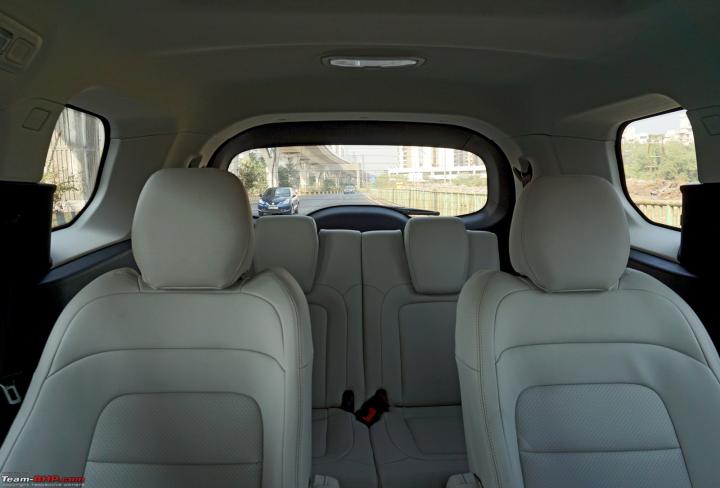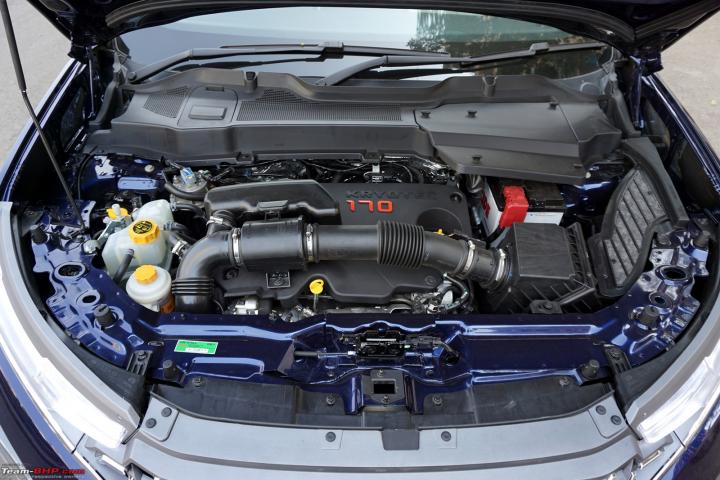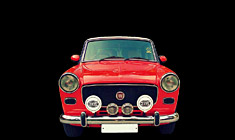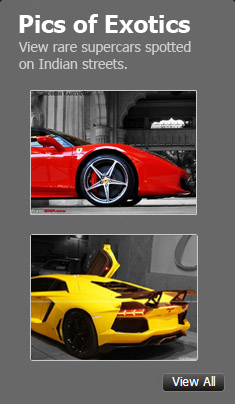News
New Tata Safari 2021: Our observations after 1 day of driving
Tata Safari 2.0L Diesel AT Review
The Safari is powered by the same 2.0L diesel engine as the Harrier, Compass & Hector. Called "Kryotec170", the motor produces 168 BHP (@ 3,750 rpm) & 350 Nm (@ 1,750 - 2,500 rpm) and is mated to a 6-speed MT or AT. One line summary = the AT is the gearbox to buy, don't even consider the MT.
The Safari is larger and as a result, heavier than the Harrier by 115 kg. It tips the scales at 1,825 kg. This gives it a power-to-weight ratio of 92 BHP / ton, which is just 6 BHP / ton lesser than the Harrier. The torque-to-weight ratio of 192 Nm / ton is lesser than the Harrier's by 14 Nm / ton. Compared to its rivals, the Safari falls behind the 100 BHP / ton and 208 Nm / ton of the Hector Plus.
The automatic gearbox has been sourced from Hyundai and is very smooth & competent (like Hyundai ATs, it's not the fastest though). Get this = the engine and AT mating is superior to that of the Jeep Compass! Just like Maruti did a better job of tuning the 1.3L MJD engine in the Swift, Tata has done a better job with the 2.0 Diesel AT than FCA itself.
Tata has put in effort to reduce the NVH levels & it shows. On start up, the body shake we experienced in the 2020 Harrier has almost disappeared. The AT is superbly tuned and enjoys a good partnership with the Kryotec170. This smooth-shifting AT makes the Safari easy to drive in the city. Lift off the brake pedal and the Safari will start crawling forward instantly. The SUV moves off seamlessly from a standstill & there is no lag to speak of. Light accelerator input is all you'll need to commute. The accelerator pedal is also feather-light, which just makes this AT that much nicer to drive. With an easy right foot, the gearbox shifts up early and shift quality is very smooth.
We will say that the AT's overall response time is "average" to "above average", as is usually the case with Hyundai torque-converters. It's not the fastest out there or the most responsive to kickdown commands and there are a few situations where you'll feel it takes longer to downshift than you'd like. That being said, the AT does a good job 98% of the time. The focus of Hyundai & Tata has clearly been on smoothness because even when it drops a gear in full kickdown mode, there's no jerk. It's polished.
On the open road, the 168 horses & 350 Nm give the Safari AT enough muscle to please even enthusiastic drivers. Fast drivers won't be left wanting on long expressways. The acceleration is quick enough and there is sufficient punch on tap at all times. This SUV is a capable cruiser that munches miles comfortably, seeing 100 km/h @ a relaxed 1,700 rpm and 120 km/h @ 2,200 rpm. Overtaking slower moving traffic is an effortless experience too & the Safari AT is a brilliant long-distance companion.
The Safari gets two selectable driving modes (apart from the default "City" mode). Because of the powerful engine, "Eco" mode is genuinely usable. It is not weak or poor at all, and we see owners using it in the city as well as for easy expressway cruising. Added benefit = because of duller responses, the drive experience is smoothest in Eco. "City" mode is a good balance between the two, but "Sport" mode is the one you want when you're in the mood for some fun / driving fast. The difference in Sport is immediately felt. There is more power available, and the accelerator itself feels so much more responsive. Sport mode keeps the engine hot by maintaining higher revs, thereby making the motor + gearbox more eager.
Shifting to manual mode automatically engages "Sport" driving mode, although very honestly, manual shifting is pointless in a gargantuan SUV like this. Even when driving aggressively, we found ourselves simply engaging "Sport" and letting the AT do all the work. We foresee owners using "manual mode" very rarely, if at all. It's also tuned conservatively (typical of Hyundai) and doesn't allow aggressive downshifts (like say, the Endeavour). Uniquely, if the gearbox disagrees with your downshift command, a prompt comes up on the MID telling you that your command has been denied. It's nice to see this sort of communication from the car - it's rare.
There are some niggles as well. During our test drive, the service warning light appeared in the instrument cluster and none of the drive modes or terrain response modes could be engaged, even when we moved the gear shifter to the manual mode position. Such a problem was also seen in an earlier Harrier media car that we had. It was sorted by turning the engine off and firing it up again. While it happened just once this time (compared to multiple times in the Harrier), Tata has to make sure it's sorted out once and for all. Very disheartening to see niggles & issues even after the model has been on sale for 2 years now. If we spotted such a problem in just a day of being with the car, imagine how many more owners might see when living with the car.
What I would like to see in the Safari is an all-wheel drive system. Tata Motors has said that such a version would be introduced only if there is sufficient demand for it. We think that's just a polite way of saying "no". Sad, because an AWD AT will make the Safari a kick-ass tourer, while also bestowing it with more marketing cred.
NVH levels have improved compared to the 2020 Harrier we drove last. There is a negligible amount of body shake on start up & none on shutdown. The AT shifts up early, hence engine sound isn't a bother when you're driving calmly in the city. Engine noise is not as prominent as the 2020 Harrier, even when the needle starts climbing. The diesel is sufficiently quiet at lower revvs. Only once it gets past 3,750 rpm does it get loud. Still, it's not as annoying as it was in the last Harrier we drove. Once past 4,000 rpm, the engine note is sad (even by diesel standards). We feel this is an "engine" problem as much as it is an "insulation" problem because the Compass gets noisy at high revs too. While road noise is average, we noticed a bit of wind noise filtering through at 90 km/h, which increases with speed. That said, it was not excessive even at 120 km/h.
Tata Safari Ride & Handling Review
The Safari is equipped with an independent McPherson strut front suspension with coil springs and an anti-roll bar, while the rear is a semi-independent twist blade design with a panhard rod. While the front is very similar to the Land Rover Discovery Sport, the rear suspension has been tuned by Lotus Engineering, UK. The Safari's ride quality is mature, but has a firm edge to it. At city speeds, it is compliant enough and the Safari's occupants will be kept comfortable. No owner will complain. Still, it's not what we would call "plush" & there is simply no comparison with cars like the Duster & Hexa. The sharpness of potholes is obvious inside & you'll feel the suspension's firmness on bad roads (with some side-to-side movement of the cabin too). Those seated in the third row will feel this more than the others. This isn’t a car that can flatten bad roads like a Duster / Hexa. In fact, the ride is a bit firmer than the Harrier's as well due to the shorter tyre sidewalls (Harrier runs on R17 rims). Our test vehicle had 18" wheels, and lesser variants get 16" rims with taller rubber. The ride quality on the 16" wheel variant will be noticeably cushier.
On the highway too, the Safari's ride quality is compliant & adequate. Yet again, it's not going to round off bumps like the Hexa could and you will always be aware of the kind of road you are driving on. What's nice is that the suspension goes about its job silently - it's not clunky or loud.
Straight line stability is very good, even at high speeds. Additionally, the Safari isn't bouncy at speed and the rear end recovers quite quickly from expressway up / down undulations. Grip levels are satisfactory from the chassis & 235 mm tyres, yet this big & heavy SUV isn't what we’d call a corner carver. Body roll is present and you feel the car’s height + weight. All of this is fine and the behaviour is acceptable as long as you drive it like a 7-seater family tourer.
On the highway, the steering is not as sensitive or twitchy as it was in the '19 Harrier we drove. It's just like the improved 2020 Harrier in that respect. That said, I have to state that it's still a level too sensitive at high speeds. Even a slight touch on the steering results in the car changing direction. Tata should dull the high-speed response even more. I wouldn't have a problem with such a steering in a hatchback or low-slung sedan, but in a large + tall + heavy SUV like this, it can make things unnerving at 120 km/h. Even so, the steering's behaviour is no deal breaker and I could take the expressway curves a lot more confidently than in the '19 Harrier.
What will truly bother owners on a daily basis is the steering's weight at parking, crawling and u-turn speeds (0 - 5 km/h). It feels hefty <5 km/h and will totally put off regular folk (especially women) who are used to light Japanese & Korean steerings. No problem once you get above 10 km/h or so. My single wish from Tata Motors is to make the steering lighter at parking / crawling speeds. I don't understand why something as simple as tuning a power steering isn't done perfectly after 2 years of the car (Harrier) being on sale.
In addition to the switchable engine remaps mentioned in the engine post, the Safari gets a Land Rover-esque terrain response system with two selectable modes (apart from the normal driving mode). Wet Mode is designed for driving in the rain by providing better traction and handling. If you should hit a rough patch on your holiday outings, Tata has you covered there too, with the Rough Road Mode which optimizes the vehicle's behavior on broken roads. Braking performance is also tuned to support rough road surfaces. This is all software trickery that can work well. We didn't get an opportunity to test either of these and their verdict will depend on the most reliable reports of them all = Team-BHP Ownership Reviews.
The laden ground clearance is 143 mm, which is 10 mm lesser than the Harrier's 153 mm.
The Safari's turning radius of 5.8 meters is big. In fact, the turning radius is on par with the huge Toyota Fortuner's!! Expect more 3-point turns than necessary in the city. Within urban confines, the Safari isn't as easy to drive as the Creta or Compass due to its size, steering weight & ergonomics (for many drivers).
ABS & EBD, ESP, hill hold, brake disc wiping, brake pre-fill, hydraulic brake fade compensation, rollover mitigation, traction control and cornering stability control are standard on all variants of the Safari, while the top XZ variant further gets hill descent control. The Safari has disc brakes at the front and rear. We jammed the brakes at high speed too and the car stopped straight & true, with no drama. The ABS doesn't kick in unless really necessary (we like it this way). Please note that the bite from the brake pedal is sharp and will take some getting used to when you are new to the car. There is a good deal of pedal travel before the brakes bite & the pedal feels a bit spongy as well. Lastly, the softer front means there is nose dive under braking (and nose rise under acceleration!!).
Continue reading the discussion on the 2021 Tata Safari on our forum.


















_0_0.jpeg)

.jpg)



